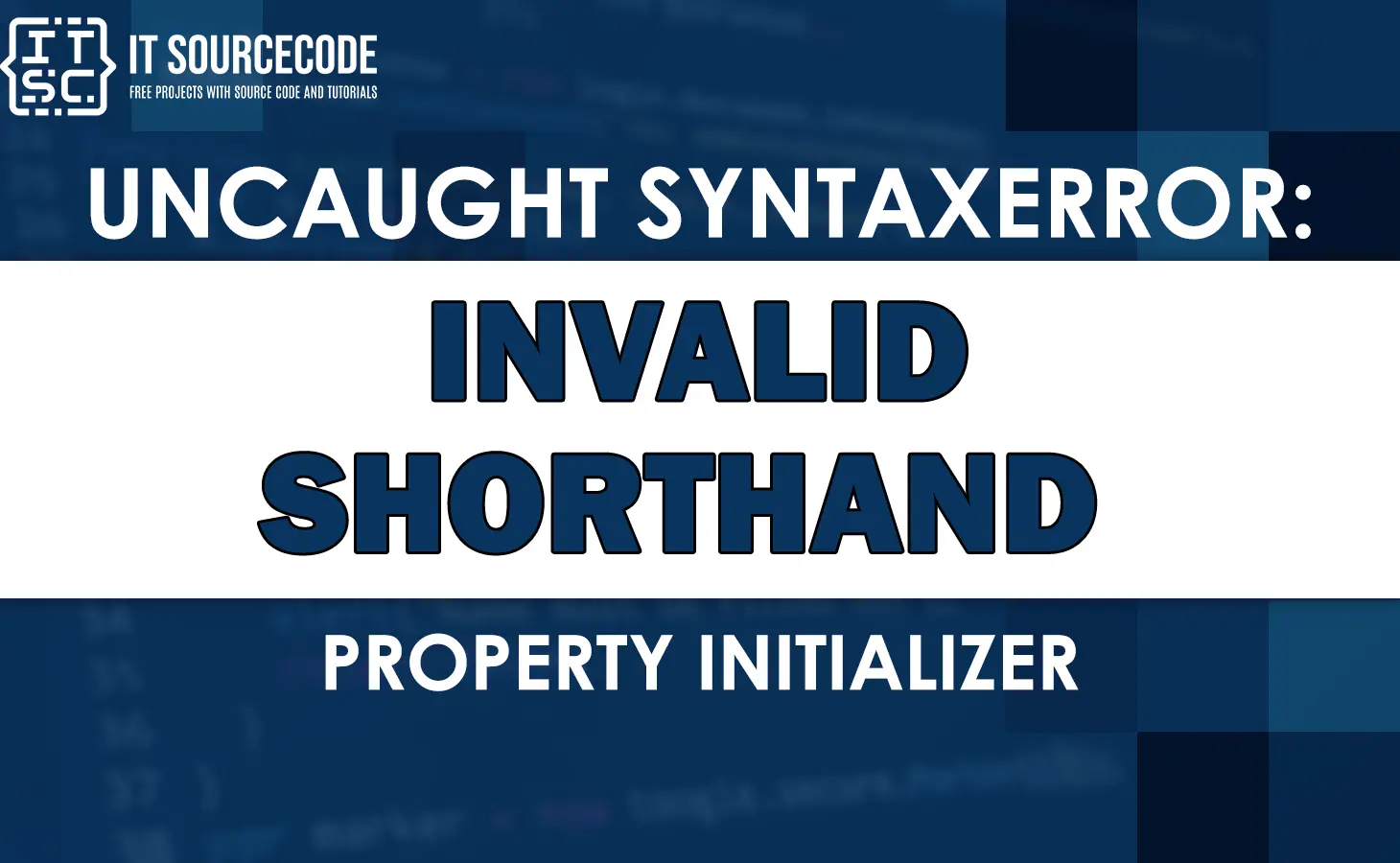This article will provide an in-depth exploration of the uncaught syntaxerror: invalid shorthand property initializer error message in JavaScript.
You will know why invalid shorthand property initializer occurs and possible solutions to fix this error.
Thus, if you’ve encountered this error while programming and find yourself confused, there’s no need to worry.
We have everything you need to understand and resolve the uncaught syntaxerror: invalid shorthand property initializer.
What is “uncaught syntaxerror: invalid shorthand property initializer”?
The error message uncaught syntaxerror: invalid shorthand property initializer occurs when you are using an equal sign (=) rather than using a colon (:) to separate the keys and values in an object.
For example:
const data = {
website = 'Itsourcecode',
visits = 1000000,
offere = 'Free sourcecode and tutorials'
}
The error message was triggered because you should use colon (:) and not equal sign (=).
Output:
Uncaught SyntaxError: Invalid shorthand property initializerWhy does “invalid shorthand property initializer” Syntaxerror occur?
The syntaxerror: invalid shorthand property initializer raised when an equal sign (=) is used instead of a colon (:) to separate the keys and values in an object.
In JavaScript, object properties are defined using key-value pairs, where the key and value are separated by a colon. Using an equal sign instead of colon results in this error message.
How to fix the “uncaught syntaxerror: invalid shorthand property initializer”?
To fix the uncaught syntaxerror: invalid shorthand property initializer, you need to replace the equal sign (=) with a colon (:) to correctly separate the keys and values in an object.
Solution 1: Replace the equal signs with colons to separate a key-value pairs
In JavaScript, object properties are defined using key-value pairs, where the key and value are separated by a colon. Using an equal sign instead of colon results in this error message.
By replacing the equal sign with a colon, you can fix this error.
Incorrect code:
const data = {
website = 'Itsourcecode',
visits = 1000000,
offere = 'Free sourcecode and tutorials'
}
Corrected code:
const data = {
website: 'Itsourcecode',
visits: 1000000,
offer: 'Free sourcecode and tutorials'
}
console.log(data);
Output:
{
website: 'Itsourcecode',
visits: 1000000,
offer: 'Free sourcecode and tutorials'
}Solution 2: Use equal sign “=” to add a new key-value pairs
if you want to add a new key-value pair to the object, you use the equal sign.
For example:
const data = {
website: 'Itsourcecode',
visits: 1000000,
offer: 'Free sourcecode and tutorials'
}
data.officialsite = 'Itsourcecode.com';
console.log(data);
Output:
{
website: 'Itsourcecode',
visits: 1000000,
offer: 'Free sourcecode and tutorials',
officialsite: 'Itsourcecode.com'
}Solution 3: When declaring a variable, you use an equal sign
When declaring a variable, it is important to use an equal sign to assign a value to it. This ensures that the variable is properly initialized and ready to be used in your code.
For example:
const website = 'Itsourcode';
console.log(website);
const arr = ['it', 'source', 'code'];
console.log(arr);
const obj = {website: 'Itsourcecode', visits: 200000};
console.log(obj);
The left-hand side of the assignment specifies the name of the variable, while the right-hand side specifies the value.
Output:
Itsourcode
[ 'it', 'source', 'code' ]
{ website: 'Itsourcecode', visits: 200000 }Solution 4: Use the object spread syntax to create the object
For example:
const obj = {
...{
website: 'Itsourcecode',
visits: 1000000,
offer: 'Free sourcecode and tutorials'
}
};
console.log(obj);
In this solution, we use the object spread syntax (…) to create a new object and copy the properties of another object into it. The spread syntax spreads the properties of the inner object into the outer object.
Output:
{
website: 'Itsourcecode',
visits: 1000000,
offer: 'Free sourcecode and tutorials'
}Solution 5: Create the object using a constructor function
For example:
function Obj() {
this.website = 'Itsourcecode';
this.visits = 1000000;
this.offer = 'Free sourcecode and tutorials';
}
const obj = new Obj();
console.log(obj);
Here, we use a constructor function to create a new object. A constructor function is a special type of function that is used to create objects.
When you call a constructor function with the new keyword, it creates a new object and sets its properties based on the code in the constructor function.
Output:
Obj {
website: 'Itsourcecode',
visits: 1000000,
offer: 'Free sourcecode and tutorials'
}Conclusion
In conclusion, the error message uncaught syntaxerror: invalid shorthand property initializer occurs when you are using an equal sign (=) rather than using a colon (:) to separate the keys and values in an object.
This error can occur in various programming languages when the syntax rules for using commas are not followed correctly.
By executing the solutions above, you can master this SyntaxError with the help of this guide.
You could also check out other SyntaxError articles that may help you in the future if you encounter them.
- Expression.syntaxerror: token comma expected.
- Uncaught syntaxerror unexpected token react
- Syntaxerror: unterminated string literal
We are hoping that this article helps you fix the error. Thank you for reading itsourcecoders 😊

